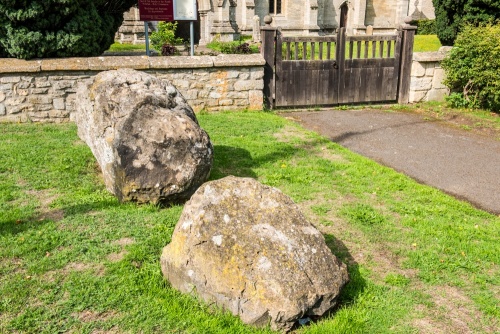
Anwick is a small village in the North Kesteven District of Lincolnshire, about 4 miles north-east of Sleaford. The parish church of Anwick is a late 13th-century building dedicated to St Edith.
Immediately outside St Edith's churchyard wall are two large boulders known as the Drake Stones. The boulders are made of Spilsby sandstone and are what is geologically known as glacial erratics. It isn't clear whether this was their original position or if they were moved to this spot.
The Legend(s)
Several local stories cling to the rocks. One tale says that a local farmer was ploughing a field when his horse and plough were sucked into the ground in an area of quicksand. Despite his frantic efforts to save the horse it was sucked under the ground and lost. As the horse disappeared, a drake (some versions say a dragon) emerged from the hole and flew away. When the villagers returned to the spot they found a stone in the shape of a drakes head.

They thought the stone might hide treasure but they could not move it. It stayed in the ground despite numerous attempts to dig for treasure beneath it. It was not until the 19th century that it was moved with the aid of a traction engine. During transport to the churchyard, the stone broke into two pieces as we see it today.
Another version of the story says that the devil lived in a cave beneath the stone, and that the cave was filled with treasure. Attempts to dig beneath the stone failed, for it seemed to have no bottom. Treasure seekers excavated a large depression that filled with water, creating a lake, so that the stone was an island.
A local farmer attached a team of strong oxen to a chain and bound the stone with the chain. The oxen strained so hard to budge the stone that the chain snapped, at which point the guardian of the stone, in the shape of a drake, took alarm and flew away at the very moment that the chain snapped.
Another, more mundane story, says that they are called Drake Stones because ducks used them for shelter.

It is hard to say whether the rocks ever were one stone; at first glance, they don't appear to have any matching edges. The stone nearest the churchyard is much larger, almost 1m high. The smaller stone is roughly half that size.
The Victorians believed that the Drake Stones were 'of Druidic origin', but there is nothing to suggest that they were ever part of any religious observance. It does seem curious that they stand in front of the churchyard, though. Might the church stand on or near a site of ancient significance?
It is extremely easy to find the Drake Stones. They stand beside the churchyard path on Church Lane, just north of the A153. There is no parking area that we could see but it was very easy to park along the verge on Church Lane.
About Anwick Drake Stones
Address: Church Lane,
Anwick,
Lincolnshire,
England, NG34 9SS
Attraction Type: Prehistoric Site
Location: Outside St Edith's churchyard on Church Lane. Parking along the verge.
Location
map
OS: TF114506
Photo Credit: David Ross and Britain Express
HERITAGE
 We've 'tagged' this attraction information to help you find related historic attractions and learn more about major time periods mentioned.
We've 'tagged' this attraction information to help you find related historic attractions and learn more about major time periods mentioned.
Find other attractions tagged with:
NEARBY HISTORIC ATTRACTIONS
Heritage Rated from 1- 5 (low to exceptional) on historic interest
South Kyme, St Mary & All Angels Church - 3.4 miles (Historic Church) ![]()
South Kyme Tower - 3.4 miles (Historic Building) ![]()
Cogglesford Watermill - 3.7 miles (Historic Building) ![]()
Sleaford, St Denys' Church - 4.1 miles (Historic Church) ![]()
National Centre for Craft and Design - 4.1 miles (Museum) ![]()
Navigation House Visitor Centre - 4.1 miles (Museum) ![]()
Sleaford Museum - 4.2 miles (Museum) ![]()
Sleaford Castle - 4.3 miles (Castle) ![]()



